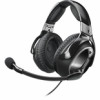Sennheiser S1 DIGITAL Instructions for use - Page 32
Valuable information on NoiseGardTM/digital, S1 DIGITAL, Feedback FB ANR, Feedforward FF ANR - anr headset
 |
View all Sennheiser S1 DIGITAL manuals
Add to My Manuals
Save this manual to your list of manuals |
Page 32 highlights
Valuable information on NoiseGardTM/digital Valuable information on NoiseGardTM/digital Combination of two NoiseGard strategies Active noise compensation (ANR, NoiseGard) is based on the principle of cancelling out unwanted sound using "anti-sound" (phase-inverted sound). There are two distinct strategies: the feedback (FB) strategy and the feedforward (FF) strategy . Operating principle of the two ANR strategies Feedback (FB) ANR uses microphones integrated inside the ear cups to pick up the sound signal near the ear. This sound signal is processed by a FB control circuit that calculates the required "anti-sound" and outputs it via the loudspeaker. This is the "classic" NoiseGard strategy used in most headsets with analog NoiseGard technology. FB-NoiseGard works especially well in the low-frequency range. Feedforward (FF) ANR, on the other hand, uses microphones mounted on the outside of the ear cups to directly pick up the unwanted noise. The FF control circuit then calculates the required "anti-sound" and outputs it via the loudspeaker. The FF control circuit cannot become unstable at higher frequencies, and therefore allows for a strikingly increased NoiseGard performance in the upper frequency range. NoiseGardTM/digital uses both ANR strategies. Each ear cup features its own inner and outer microphones and a loudspeaker, allowing the advantages of both the FB and FF strategies to be combined. As a result, the NoiseGard performance is outstanding both in terms of the amount of noise attenuation and the wide range of frequencies over which it is effective. S1 DIGITAL | 31















